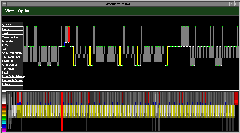|
NOTE: This content is a bit dated. For more up-to-date news on
InfoVis research here at Georgia Tech, please see the InfoVis pages from the
Information Interfaces Group.
Within the context of software visualization, our research is
developing ways of visualizing information sources and data as a means
toward helping people interpret and understand the information. In
particular, we are focusing on depicting large information spaces,
which often contain more informational elements than there are pixels
on the screen. The origins of this work are visualizations of large
programs and software systems. Two particular techniques, the
Information Mural and semantic zooming, are discussed below.
We also are doing a number of other information visualization projects
not focusing on software visualization. To learn more about them,
check out the InfoVis in the Information
Interfaces Research Group web pages. Also, we currently teach a
graduate course,
CS 7450, focusing on Information Visualization.
Information Mural
 Pictured here is
a visualization of the message sequence during the execution of a C++ program. The lower part of this display contains what we call an Information Mural, which in this case is a representation of over 50,000 messages that fits in a space around 500 pixels wide. As such, Information Murals can portray very large information spaces completely within one window (without the need for scrolling), even when the number of information elements outnumbers the number of pixels.
Pictured here is
a visualization of the message sequence during the execution of a C++ program. The lower part of this display contains what we call an Information Mural, which in this case is a representation of over 50,000 messages that fits in a space around 500 pixels wide. As such, Information Murals can portray very large information spaces completely within one window (without the need for scrolling), even when the number of information elements outnumbers the number of pixels.
Formally, an Information Mural is a 2D,
reduced representation of an entire information space that fits completely
within a display window or screen. The mural is created using anti-aliasing
techniques and various visual attributes such as intensity shading, color,
and pixel size. These murals have proven useful for visualizing large
information sources such as program executions, text files, or data.
More details and examples are available.
Semantic Zooming
Understanding and interpreting a large data source is an important but
challenging operation in many technical disciplines. In software
visualization, illustrating the operation of very large programs or
programs working on very large data sets has remained one of the key
open problems. We have introduced an approach that uses semantic
zooming to depict large program executions. Our method utilizes
abstract, clustered graphics to portray program operations on the
entire data set. Then, by interacting with the presentation, a viewer
can zoom in to examine details and individual values. At this
"magnified" level, the presentation adjusts to reflect displays
common in existing algorithm animation and program visualization
systems.
Other Research
We are also working on visualization techniques for understanding the
NEO
distributed object system from Sun.
Pertinent references include:
Stasko, John, Catrambone, Richard, Guzdial, Mark and McDonald, Kevin,
"An Evaluation of Space-Filling Information Visualizations for Depicting
Hierarchical Structures", International Journal of
Human-Computer Studies, Vol. 53, No. 5, November 2000, pp. 663-694.
Stasko, John T. and Zhang, Eugene, "Focus+Context Display and Navigation
Techniques for Enhancing Radial, Space-Filling Hierarchy
Visualizations", Proceedings of IEEE Information Visualization 2000,
Salt Lake City, UT, October 2000, pp. 57-65.
Stasko, John T. and Zhang, Eugene, "
Focus+Context Display and Navigation Techniques for Enhancing Radial,
Space-Filling Hierarchy Visualizations", Graphics, Visualization,
and Usability Center, Georgia Institute of Technology, Atlanta, GA,
Technical Report GIT-GVU-00-12, August 2000.
Stasko, John, Catrambone, Richard, Guzdial, Mark and McDonald, Kevin, "
An Evaluation of Space-Filling Information Visualizations
for Depicting Hierarchical Structures",
Graphics, Visualization, and Usability Center, Georgia Institute of
Technology, Atlanta, GA, Technical Report GIT-GVU-00-03, February
2000.
Jerding, Dean and Stasko, John, "The Information Mural: A Technique for
Displaying and Navigating Large Information Spaces," IEEE
Transactions on Visualization and Computer Graphics, Vol. 4,
No. 3, July-Sept. 1998, pp 257-271.
Jerding, Dean and Stasko, John T., "
The Information Mural: A Technique for Displaying and Navigating
Large Information Spaces", Graphics, Visualization, and Usability Center,
Georgia Institute of Technology, Atlanta, GA, Technical Report
GIT-GVU-97-24, December 1997. (Replaces 96-25).
Jerding, Dean and Stasko, John T., "
The Information Mural: Increasing Information Bandwidth in
Visualizations", Graphics, Visualization, and Usability Center,
Georgia Institute of Technology, Atlanta, GA, Technical Report
GIT-GVU-96-25, October 1996.
Stasko, John T. and Muthukumarasamy, Jeyakumar,
"Visualizing Program Executions on Large Data Sets", Proceedings of
the IEEE Symposium on Visual Languages, Boulder CO, September 1996,
pp. 166-173.
Jerding, Dean and Stasko, John T., "
Visualizing Message Patterns in Object-Oriented Program
Executions", Graphics, Visualization, and Usability Center,
Georgia Institute of Technology, Atlanta, GA, Technical Report
GIT-GVU-96-15, May 1996.
Jerding, Dean and Stasko, John T., "Using Information Murals in
Visualization Applications" (Formal Demonstration),
Proceedings of the ACM UIST '95 Conference, Pittsburgh, PA, November
1995, pp. 73-74.
Jerding, Dean and Stasko, John T., "The Information Mural: A
Technique for Displaying and Navigating Large Information Spaces",
Proceedings of the IEEE Symposium on Information
Visualization, Atlanta, GA, October 1995, pp. 43-50.
Muthukumarasamy, Jeyakumar and Stasko, John T., "
Visualizing Program Executions on Large Data Sets Using Semantic
Zooming," Graphics, Visualization, and Usability Center, Georgia
Institute of Technology, Atlanta, GA, Technical Report GIT-GVU-95-02,
January 1995.
|
|
|
|
|

